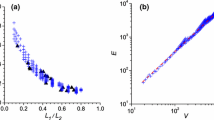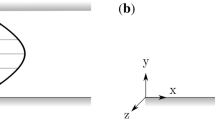Abstract
A new formulation of the problem of the statistical stability of fully turbulent shear flow is proposed, in which one seeks mean fields that bound the observed flow from the stable side. In the spirit of maximum transport theory, this formulation admits a larger set of “flows” than are dynamically possible. A sequence of constraints derived from the equations of motion can narrow this set, permitting at each step the determination of a “most stable” field free of any empirical elements. Turbulent channel flow is proposed as the first application and test of this quantitative theory. Past deductive theories for this flow, from “mean field” to “transport upper bounds,” are assessed. It is shown why these theories do not retain the significant destabilizing mechanisms of the actual flow. The implications for turbulent flow of recent work on the nonlinear and three-dimensional instability of laminar shearing flow are described. In first exploration of the “decoupled mean” stability theory proposed here, approximate analytical and numerical stability methods are used to find an amplitude and structure for the averaged flow propoerties. The quantitative results differ by considerably less than two from the observed values, providing an incentive for a more complete numerical study and for further constraints on the admitted class of flows. In the language now current for nonlinear stability theory, evidence is advanced here that anN-dimensional central manifold is adjacent to the realized turbulent flow, whereN has the largest possible value compatible with the dynamical relations.
Similar content being viewed by others
References
Busse, F. H. (1978),The optimum theory of turbulence, Adv. Appl. Mech.18, 77–121.
Carlson, D. R., Widnall, S. E., andPeeters, M. F. (1982),A flow-visualization study of transition in plane Poiseuille flow, J. Fluid Mech.121, 487–505.
Chan, S. K. (1971),Infinite Prandtl number turbulent convection, Stud. Appl. Math.50, 13–49.
Féjer, L. (1916),Uber trigonometrische Polynome, J. Reine Angew. Math.146, 53–82.
Herbert, T. Periodic secondary motions in a plane channel, InProc. 5th Int. Conf. on Numerical Methods in Fluid Dynamics (ed. van de Vooren, A. I., and Zandbergen, P. J. (Springer, Berlin 1976) p. 235.
Herbert, T. (1980),Nonlinear stability of parallel flows by high-order amplitude expansions, AIAA J.18, 243.
Howard, L. N. (1972),Bounds on flow quantities, Annu. Rev. Fluid Mech.4, 473–494.
Joseph, D. D. Stability of Fluid Motions (2 vols) (Springer, Berlin 1976).
Klebanoff, P. S. et al. (1981),Turbulent boundary layer at low Reynolds number, Phys. Fluids24, 802–811.
Lin, C. C. The Theory of Hydrodynamic Stability (Cambridge University Press, Cambridge, England 1955).
Malkus, W. V. R. (1979),Turbulent velocity profiles from stability criteria, J. Fluid Mech.90, 401–414.
Orszag, S. A., andPatera, A. (1980),Subcritical transition to turbulence in plane channel flows, Phys. Rev. Lett.45, 989.
Orszag, S. A., andPatera, A.,Transition and turbulence in lane channel flows, InProc. 7th Int. Conf. on Numerical Methods in Fluid Dynamics (ed. MacCormack, R. W., and Reynolds, W. C.) (Springer, Berlin 1981).
Reynolds, W. C., andTiederman, W. G. (1967),Stability of turbulent channel flow, with application to Malkus’s theory, J. Fluid Mech.27, 253–272.
Stern, M. E. (1979),Inequalities and variational principles for turbulent transport, J. Fluid Mech.91, 513–540.
Tung, K. K. (1981),Barotropic instability of zonal flows, J. Atmosph. Sci.38, 308–321.
Virk, P. (1975),Drag reduction fundamentals, AIChE J.21, 4.
Zahn, J. P., Toomre, J., Spiegel, E. A., andGough, D. O. (1974),Nonlinear cellular motions in Poiseuille channel flow, J. Fluid Mech.64, 319.
Author information
Authors and Affiliations
Rights and permissions
About this article
Cite this article
Malkus, W.V.R. The amplitude of turbulent shear flow. PAGEOPH 121, 391–400 (1983). https://doi.org/10.1007/BF02590148
Received:
Accepted:
Issue Date:
DOI: https://doi.org/10.1007/BF02590148




